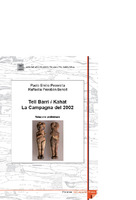Tell Barri/Kahat: la campagna del 2002
| dc.relation.isnodouble | 9623f264-5037-4d8c-b9e1-5bcee188867e | * |
| dc.relation.isnodouble | a3e8fbf2-3a0c-4b2b-801e-95e42774c172 | * |
| dc.contributor.author | Pecorella, Paolo Emilio | |
| dc.contributor.author | Pierobon Benoit, Raffaella | |
| dc.date.accessioned | 2010-10-04 00:00:00 | |
| dc.date.accessioned | 2020-04-01T15:24:40Z | |
| dc.date.available | 2020-04-01T15:24:40Z | |
| dc.date.issued | 2005 | |
| dc.identifier | 356392 | |
| dc.identifier | OCN: 1166423828 | en_US |
| dc.identifier | 437400516 | en_US |
| dc.identifier.uri | http://library.oapen.org/handle/20.500.12657/34733 | |
| dc.description.abstract | In the undulating plains of north-eastern Syria is the site of Tell Barri, identified with the city of Kahat. The archaeological sequence which has been brought to light stretches without interruption from the start of the third millennium up to the fourteenth century AD. This report records the results of the eighteenth excavation campaign, carried out by the group from the University of Florence and from the "Federico II" University of Naples. In Area G, the excavation of the chapel dating to the third millennium proceeded, bringing to light a palatine building that can be attributed to the Mid Assyrian King Adad-Nirari I. In Areas A and J, the Parthian, Hellenistic and Achemenidian layers were excavated up to the level of the Neo-Babylonian reoccupation of the Assyrian palace of Tukulti-Ninurta II. As regards the Parthian phase, investigation has proceeded on the Great Defensive Wall and on the large edifice in the lower city. The text, delivered for printing in July 2005, was published following the tragic death of Paolo Emilio Pecorella, which took place on 29 August in Tell Barri, in the course of the excavation campaign. | |
| dc.language | Italian | |
| dc.subject.classification | thema EDItEUR::N History and Archaeology::NH History::NHF Asian history | en_US |
| dc.subject.classification | thema EDItEUR::N History and Archaeology::NK Archaeology | en_US |
| dc.subject.other | archaeological excavations | |
| dc.subject.other | archaeological sources | |
| dc.subject.other | tell barri | |
| dc.subject.other | scavi archeologici | |
| dc.subject.other | fonti archeologiche | |
| dc.subject.other | kahat | |
| dc.title | Tell Barri/Kahat: la campagna del 2002 | |
| dc.type | book | |
| oapen.abstract.otherlanguage | Nelle ondulate pianure della Siria nord-orientale si trova il sito di Tell Barri, identificato con la città di Kahat. La sequenza archeologica portata alla luce va dall'inizio del III millennio sino al XIV secolo d.C, senza soluzione di continuità. La presente relazione dà ragione dei risultati della diciottesima campagna di scavo ad opera del gruppo dell'Università di Firenze e dell'Università 'Federico II' di Napoli. Nell'Area G è proseguito lo scavo del sacello del III millennio e si è messo in luce un edificio palatino attribuibile al re medio assiro Adad-Nirari I; nelle Aree A e J sono stati scavati gli strati partici, ellenistici ed achemenidi, sino al livello della rioccupazione neobabilonese del palazzo assiro di Tukulti-Ninurta II. Per la fase partica è proseguita l'indagine sia del Grande Muro di Difesa sia del grande edificio della città bassa. Il testo, consegnato per la stampa a luglio del 2005, vede la luce dopo la tragica scomparsa di Paolo Emilio Pecorella, avvenuta il 29 agosto a Tell Barri, nel corso della campagna di scavo. | |
| oapen.identifier.doi | 10.26530/OAPEN_356392 | |
| oapen.relation.isPublishedBy | bf65d21a-78e5-4ba2-983a-dbfa90962870 | |
| oapen.relation.isbn | 8884532922 | |
| oapen.identifier.ocn | 1166423828 | |
| oapen.identifier.ocn | 437400516 |

